Matador Network's Blog, page 1045
July 30, 2019
Best things to do in Bonito, Brazil

Hiding in the hemline of the Amazon basin is Bonito, Brazil. Like a looking glass to the underworld, it’s one of the most precious places in South America. While the surface is an unassuming place of ochre landscapes, beneath the layers is a destination worthy of its name, which is Portuguese for “beautiful.”
It’s the gateway to the Pantanal region, yet in this maze of brushlands, the focus turns from the Pantanal’s jaguars and spectacled caimans to serene natural aquariums. Located in the Brazilian state of Mato Grosso do Sul, the magical and seemingly mythical waterways offer shallow, warm, undulating pools that are clear as glass. Credited as the cleanest water on the continent, the area’s rivers, lakes, and waterfalls beckon to an elite class of adventures in search of a freshwater paradise and fairy forests.
River snorkeling from Barro do Sucuri to Rio da Prata

Photo: ferrari.alvaro/Shutterstock
Those lucky enough to discover Bonito are often tipped off during excursions in nearby Paraguay and Bolivia or from the neighboring Pantanal, which is popular for safari-like tours into Brazil’s tropical wetlands. On a day trip from any of these destinations, outdoor lovers succumb to the allure of freshwater river snorkeling, perhaps the best on the planet.
The shallow, calm, and crystalline water of the Rio Sucuri stems from natural springs boasting stable 77-degree temperatures, abundant aquatic life, and epic environs mirroring both the Amazon rainforest and the Chaco savannah. The pristine freshwater takes its clarity from a high limestone concentration, which acts as Mother Nature’s most efficient filter. White sandy river bottoms, typically aquamarine skies, and verdant green foliage work together to create the illusion of viridescent rivers, lakes, and waterfalls.

Photo: Stephanie Frias
Foolproof snorkeling tours in either the Barra do Sucuri, the Rio Sucuri, or the Rio da Prata allow even the most inexperienced swimmers and snorkelers the chance to cherish one of the most unique landscapes in the Americas. It is an opportunity like no other to commune with nature, lazily floating fin to fin among the underworld creatures of the Amazon, like the metallic dorado and the citrus-striped piraputanga fish. A lucky few might even encounter the legendary but surprisingly docile anaconda, tapirs, or giant river otters. Above water, toucans, macaws, anteaters, and capuchin monkeys gaze down on the less-graceful human species.
Brazil’s ecotourism hideaway
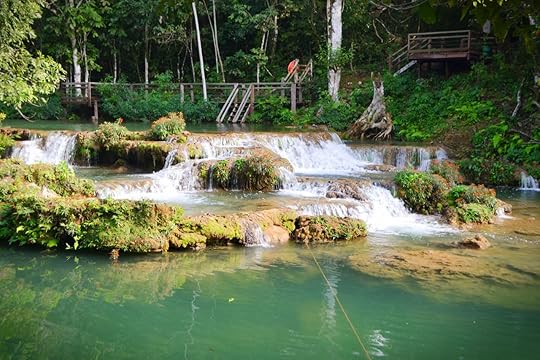
Photo: Stephanie Frias
Although the main draw of Bonito is the experience of freshwater snorkeling in the Amazon wetlands, it would be a genuine misstep to visit without seeing the rest. Beyond the miles upon miles of scenic rivers, Bonito is an eco-tourism hub regarded as the best in Brazil. The serene waterways and impressive landscapes definitely do not end at the riverbank. In fact, for genuine adventure lovers, outdoor enthusiasts, and remote travel aficionados, there is plenty to do in Bonito for a week or more.
Plan the trip wisely, booking with the hospitality-rich, budget-happy, eco-friendly, family-friendly Bonito HI Hostel (a subsidiary of Hostelling International). Not only does the oasis boast a private swimming pool, on-site cafe, and rooms with reliable WiFi, hot showers, and air conditioning, but it’s also a glorified tour company. Staying here makes it easy to book tours to more than 40 attractions in this stunning, rural community of Mato Grosso do Sul. From group dorms to private rooms, grassy campsites, and parking for overlanders, Bonito Hi Hostel is a hit for travelers who want to save on where they stay, skimp on complications, and splurge on experiences.
Bonito is packed with waterfalls.

Photo: Stephanie Frias
Although there may be an abundance of waterfalls in Brazil and the outlying Amazon areas, not all cascades are equal. In Bonito, the waterfalls are those of fantasy: easily accessible, gem-hued, and suitable for swimming. The Parque das Cachoeiras is the local star, a mile-long scenic pathway that accesses seven breathtaking waterfalls.
The guided boardwalk-esque tour winds through the forest, along the impossibly cerulean colored Mimoso River, dropping into pool and after pool of fairyland waterfalls. The lack of any notable ascent or descent on the trail is paired with calm, shallow ponds — making this waterfall route suitable for most ages and ability levels.
Captivating caves with fossils

Photo: ThiagoSantos/Shutterstock
A trip to the Amazon underworld wouldn’t be sufficient without a peek into the dark and mysterious caves and lakes that lie below the surface. From Bonito, there are three notable realms, particularly captivating for spelunkers but equally alluring for those who prefer other extremes like scuba and abseiling.
As if aquarium-like rivers and fantasy waterfalls were not enough, Bonito is also home to at least three notable caves: Grutas de São Miguel, Gruta São Mateus, and the truly epic Gruta do Lago Azul. The latter is one that will be hard to keep secret for long: an intense sapphire and tourmaline lake cradled 330 feet below the surface, it’s one of the largest water-filled caves on the planet. The natural monument is an icon of Bonito, inherently protected under conservation statuses, with limited tours offered daily.
Encrusted by impressive stalactites and stalagmites, the crystalline waters appear vibrantly hued through a careful balance of sunlight and minerals. The walls reflect 10,000-year-old fossils like saber-tooth tigers and giant sloths while the bottom of the lake — over 285 feet down — has never been reached.
Touring the forest and seeing boa constrictors

Photo: Projeto Jiboia/Facebook
From below the treetops, adventurers can truly relish Bonito. You can take to the sky with tours that go just below the forest canopy through a high-rope trail that’s over a mile long, 65 feet above ground at Sitio Ybira Pe. The canopy park dangles above the Rio Formoso, offering full-day passes for swimming beyond completion of the canopy ropes course.
Bonito even has its very own boa project, locally known as Projeto Jibóia. This educational facility and presentation is all about the large and lovable native snake, the boa constrictor. Each night, visitors are invited to view dozens of live snakes, listen in on a presentation that preaches education over hysteria, and, finally, hold one of the large snakes for an unforgettable finale.
Resort oases in the hot sun

Photo: Stephanie Frias
And then there are the beaches designed as day resorts, offering the splendor of countless clear water lakes and rivers in a setting suitable for sunning, swimming, snorkeling, zip-lining, paddleboarding, platform diving, and more.
The options are truly endless in this regard, but notable mentions go to Praia da Figueira and Balneário do Sol. Choose the first for soaking up the unfathomable Brazilian sun and the second for slinking into an Amazonian oasis.
Praia da Figueira is a wide-open lake, alternating between emerald depths and shallow toasty-hued shorelines. It’s a favorite for the serene countryside vibe and diverse water sport activities. Water-sunken pagodas and beachside lounge chairs offer perfectly acceptable sights of the walking dock and lake activities. But the main attraction is the beautiful black dorados swimming like water ballerinas just below the surface on the lapping shoreline.

Photo: Stephanie Frias
Balneario do Sol is something of an entirely different stroke, boasting grassy knolls alongside natural pools that mimic the ebb and flow of the passing lazy river. Resident capuchin monkeys hop to and from trees to picnic tables, leaning over the banks for a lick of drink beneath the waterfalls. The jungle-laden hideaway also offers playgrounds, a giant chessboard, zip-lining, and diving platforms for sinking beneath the surface of the bottle-green waterway. 

More like this: The Pantanal in Brazil is the best wildlife-watching spot in South America
The post Freshwater snorkeling in ethereal Bonito is Brazil’s best-kept secret appeared first on Matador Network.

Holiday Inn removing mini toiletries

If you regularly restock your shampoo supply by pilfering the mini bottles from hotel rooms, you’re going to have to find a new scam to save a couple of bucks. The miniature toiletries are about to be removed from all hotels run by InterContinental Hotels Group (IHG), which owns both Holiday Inn and Crowne Plaza hotels.
To reduce negative environmental effects, the hotel group has pledged to remove the plastic bottles from all of its 843,000 rooms by 2021, and has already done so at about a third of its properties, the BBC reported.
Although guests won’t be able to pocket the shower gels, they will still be able to have a soapy shower when staying at an IHG property — the mini toiletries will be replaced by bulk items.
And toiletries are just the first step. Keith Barr, IHG’s chief executive, revealed that the next hurdle will be to eliminate plastic plates and cutlery used in the hotel breakfasts, and IHG has also committed to reducing its carbon footprint per occupied room by six percent by next year.
Of course, if you care about the future of our planet, you don’t have to wait until big hotel chains get a move on — becoming a zero-waste traveler by using soap and shampoo bars instead of bottles is easy peasy. 

More like this: You can feel good about staying in these beautiful zero-waste, eco-friendly hotels
The post Holiday Inn to remove all mini toiletries from its rooms appeared first on Matador Network.

How to use the internet in China

Walk off the plane in Beijing and tap the Facebook app on your phone and you’re in for a frustrating surprise. Google, Facebook, and many other social media and search engines are blocked in China by what’s known as the Great Firewall — essentially, the Chinese government’s mega-censorship of the internet to prevent the population from accessing information or opinions that aren’t favorable toward the Chinese Community Party. In addition, many foreign cell phone service providers are unreliable or flat-out unusable in the country. Fortunately for travelers, there are ways around just about every part of the firewall and phone issue. Here’s what you need to know about internet and cell phone use before heading to China.
Get a local SIM card.

Photo: Shuang Li/Shutterstock
Smartphone service from US and Canadian service providers often doesn’t work in China, at least not to its full ability. If yours does, expect a hefty fee — T-Mobile reportedly does connect with a provider there but charges $2.99 per minute for calls coming into and out of the country.
Among the first steps you should take upon arriving in China is to buy a local SIM card. These are available in airports and shopping centers in cities throughout the country, just look for a sign in the window advertising SIM cards. You can also buy SIM cards on Amazon, though be sure you’re buying from a reputable seller to ensure there is actually data on the card when it arrives. The cost depends on how long you plan to be there and how much data and call time you want to have available. An eight-day SIM card should cost between $10 to $15, depending on where you buy it, and a 30-day card should run about $20. While these prices are quite affordable, remember that they don’t provide unlimited use — you’ll reach a set data or call time limit, so be mindful of how much time you spend browsing the web.
For a foreign SIM card to work on your mobile phone, your device must be “unlocked,” meaning it is not tied to your service provider (Sprint, AT&T, and so on). In general, if you buy your phone from the provider, it is “locked” and data and phone service will only work with that provider’s SIM card until your contract is up. However, there are some providers that sell phones that are already unlocked, such as Verizon, which does not lock any of its 4G LTE devices (like any iPhone models above iPhone 5, for example).
If the phone is from an Apple Store or another unaffiliated seller, and bought at full price, it will be unlocked. One way check this on an iPhone is by heading to the “Mobile Data” section and looking for the Mobile Data Network button. If this appears, your phone is probably unlocked as locked phones don’t have the option to operate on another network. As the aforementioned method isn’t foolproof, calling your provider to ask or trying out a different SIM card in your phone are two other options to find out whether or not it’s unlocked.
Many tech sites and blogs walk you through how to unlock your phone, but keep in mind that if your phone is under contract with your carrier, i.e. if you’re paying it off via an amount added to your phone bill each month, it is likely tied legally to your carrier until that contract is up.
Buy a MiFi or other portable Wi-Fi device.

Photo: Khai9000Pictures/Shutterstock
The ever-expanding world of technology constantly tosses out new terms to remember, but here’s one that travelers to China shouldn’t board their plane without knowing: the MiFi, aka a personal and portable Wi-Fi device. MiFi works like a home router, except it’s small and mobile — it does not need to be plugged in to establish a network for wireless connection. It’s a reliable option for internet access abroad and can be shared with several users via a password. You can use a MiFi as part of a monthly plan or with a no-contract, pay-as-you-go scheme. MiFi can serve as an alternative to having your phone unlocked or buying a local SIM card, but you will still be subject to China’s internet firewall unless you use a VPN, which we discuss below. Also, this is only for internet use — MiFi won’t help your cause should you need to make a phone call.
Use a VPN.
The best way to have access to the full internet in China is to set up a VPN, or Virtual Private Network. A VPN is installed onto your computer through the VPN provider’s secure webpage and stands as a cloaking middleman between your computer and the world beyond. It works around China’s Great Firewall because it sets your browsing location to wherever the VPN server you are connected to is — meaning that the sites you visit will think that’s where you are located. The firewall never has a chance to block you from accessing a forbidden site because your IP address isn’t from China. A VPN also gives you an extra layer of privacy and security when connecting to unknown Wi-Fi networks. You can set your location to wherever it is you want the web to think you currently are and ensure that the data flowing to and from your computer is encrypted. Think of this an extra security buffer in addition to being a way around accessing restricted websites.
Most VPN services work in China, but some are specifically marketed to travelers heading there. Among the most popular are ExpressVPN, BufferedVPN, and NordVPN. Go with one of these providers, mostly for the peace of mind of knowing that it will both work and be safe. These services aren’t free, however — expect to pay a monthly rate of anywhere from $6 to $15. After you choose a provider and sign up, download the app of that specific VPN and follow the instructions to install it.
Addressing general tech paranoia in China

Photo: Lewis Tse Pui Lung/Shutterstock
Remember that the VPN masks your location, and thus works around the Great Firewall. No one is stalking you, beyond the advertisers and cookies that already monitor your every digital move.
Everything recommended in this article is perfectly legal, including unlocking your phone. While this was once a more shady exercise, the Federal Communications Commission passed legislation in 2015 that made the practice permissible as long as the phone isn’t under contract with the carrier.
In China, you’re going to be monitored from every angle by street cameras in most public places — that’s part of the gig there. Keep in mind that the country has 1.36 billion people so anonymity on the street as a traveler is easy enough to maintain. Don’t make any noticeable gestures or speech against the Communist government either online or in-person, and you’ll be fine.


More like this: 10 things you need to know before visiting the Great Wall of China
The post Everything you need to know about internet and cell phone use in China appeared first on Matador Network.

Greta Thunberg to sail

Teenage Swedish climate activist Greta Thunberg will sail across the Atlantic Ocean in a high-speed racing yacht next month, en route to the UN climate summit taking place in New York City in September and in Santiago, Chile, in December. Thunberg, who refused to fly because of the carbon footprint associated with air travel, believes that the two upcoming climate summits are where the future of our planet will be decided.
Of course, traveling from Europe to the US without flying is a challenge, especially when cruise ships are not an option (their carbon emissions are also too high), but dedicated Thunberg found a way.
Good news!
I’ll be joining the UN Climate Action Summit in New York, COP25 in Santiago and other events along the way.
I’ve been offered a ride on the 60ft racing boat Malizia II. We’ll be sailing across the Atlantic Ocean from the UK to NYC in mid August.#UniteBehindTheScience pic.twitter.com/9OH6mOEDce
— Greta Thunberg (@GretaThunberg) 29 juillet 2019
German property developer Gerhard Senft is offering the services of his high-speed, 60-foot-tall yacht named Malizia II. Built for the solo, nonstop, around-the-world Vendée Globe race, the yacht is equipped with solar panels and underwater turbines, making it completely carbon neutral. Those accompanying Thunberg are the ship’s skipper, Boris Hermann; her father; a filmmaker; Pierre Casiraghi, grandson of Monaco’s late Prince Rainier III; and actress Grace Kelly.

Photo: Greta Thunberg/Facebook
While in NYC, Thunberg will participate in several meetings and protests before traveling by train and bus to the UN climate conference in Chile in December, The Guardian reported. 

More like this: How frequent flyers can offset their flight emissions
The post Greta Thunberg will sail across the Atlantic to attend UN climate summits appeared first on Matador Network.

VR waterslide experience

This summer has been brutally hot, breaking temperature records all over the place — the UK reached 100.6 degrees and Paris went all the way up to a mind-boggling 108.7 degrees last Thursday.
Luckily, a new product designed by German waterslide company Wiegand Waterrides and aquatic virtual reality experts Ballast VR is making it easy for people to cool off and escape the reality of the heat wave. They’ve developed a virtual reality headset that, when equipped during a waterslide ride, creates a fully immersive adventure experience that will knock your swimsuit right off.
This advanced VR experience can be adapted to work with any existing waterslide. The headset is lightweight, waterproof, and simple to operate. The headset comes loaded with a variety of virtual worlds that will bring the wearer on a surprising adventure. 

More like this: The 7 strangest theme parks around the world
The post This VR waterslide experience is the best way to escape the summer heat appeared first on Matador Network.

July 29, 2019
Luxury hotels with in-room gyms

The gym was sucking me in, like a siren of spinning luring me from my hungover appointment with a Mimosa.
Waking up earlier than I’d wanted after a long night out in Chicago, my plan had been to continue the party with some Champagne leftover from the night before. But the in-room gym at the Swisshotel’s Vitality Suite had other ideas. As I walked by the 200-square-foot fitness center — which sat between my bedroom and the living room in this 1,700-square-foot behemoth of a suite — I almost heard the gym equipment talking to me.
“Hey there, party boy,” it teased. “You gonna let a little hangover keep you from getting your workout in? I mean we’re RIGHT HERE. And we’re read…”
I sighed.
“Ok,” I responded as you might to friends pressuring you to go out on a Friday night you really meant to spend in. “Let me put on some clothes.”
A gym that shames you into exercise

Photo: Swissotel
“Having a fitness center in your room will seduce you into working out,” says Diana Mestre, the Corporate Spa Consultant for Velas Resorts, who has in-room fitness centers in its luxury hotels throughout Mexico. She fully understood what happened to me at the Vitality Suite. “Otherwise you just get up and have breakfast, and that’s it.”
As wellness becomes an increasing focus of lifestyle both at home and away, hotels are competing to see who can keep people in the best shape while traveling. And in-room gyms seem to be the most effective way of doing that.
“When you travel, you’re off your routine. You’re out of whack,” says Armando Hernandez, the General Manager of the EVEN Hotel Miami Airport. “This helps you continue down the wellness path.”

Photo: EVEN Hotels
EVEN Hotels, whose in-room fitness concept is also in New York, Seattle, Pittsburgh, and other top US destinations, has brought the in-room gym to the masses, offering small-to-midsized gyms in each of its rooms. Those include resistance bands, yoga mats, physio balls, and, in some cases, spin bikes with on-demand classes on the television.
The hotel’s not subtle about encouraging guests to work out either, with a massive mural reading, “Your dedication is our inspiration,” on the fitness center wall. It’s the first thing you see at check-in, sitting right behind the front desk. Inside the gym, fit-looking people who opted to exercise outside their rooms occupy about half of its high-tech equipment.
“Sometimes you need some inspiration,” says Hernandez, smiling at the mural. “Because this hotel has wellness and athletics and the opportunity to work out, it inspires you to want to work out, to want to continue to have a routine where you’re working out, eating healthy.”
A decades-old concept finally catches fire
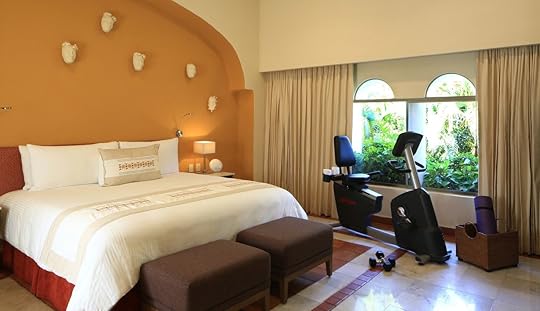
Photo: Casa Velas
The idea of gyms in rooms isn’t radically new. The Kimpton Topaz in Washington DC has been offering in-room gyms since it opened in 2001, using them because they didn’t have room for a main gym in space-cramped Washington. Those included an elliptical, spinning bike, or recumbent bike, plus a yoga mat, blocks, and resistance bands.
Gyms have been in premium suites — like my room in Chicago — for years. And granted that room (which Swissotel graciously let me sample for the purposes of this story) is an over-the-top example and runs about $1,300 a night. But fitness suites have become an entire class of rooms, many only costing $30-50 a night more than standard ones.
That’s about the price of one class at SoulCycle.
The Loews Atlanta, for example, offers a Lifestyle Suite, which comes complete with Peloton bike. The Westin Los Angeles also has Pelotons in its Westin Workout suites, in addition to a special wellness pack with healthy treats and gym clothes you can borrow.
The in-room gym is spreading beyond the luxury sphere, into hotels far more accessible to regular people. Hilton recently launched its Five Feet to Fitness program in a handful of its usually staid locations, ranging from a DoubleTree at the Orlando Airport to the American Hotel in Downtown Atlanta. The program brings 11 different pieces of fitness equipment into rooms — think on-demand fitness videos, Wattbike spin cycles, and sand balls.
This signals a changing motivation in the traveling public, that even those who aren’t business travelers spending half their lives in hotels, or travel specifically for wellness, want exercise as part of their hotel experience.
“About 89 percent of travelers are not wellness travelers, so they’re not always immediately on board,” says Velas’ Mestre. “But wellness tourism is growing… faster than commercial tourism, and people are looking to improve health and wellbeing, but they don’t wanna be forced into a retreat-type program. This is allowing guests to try new things and work out in your room, and may change the course of your life. You can come back home and say that was wonderful, I’ll start my training routine.”
The point is, you don’t need to go to a fancy spa with mountain views and soothing music to get yourself onto a fitness path. Sometimes you just need motivation five feet from your hotel bed.
Back in the Vitality Suite, my friend who’d crashed in the living room after our long night out was shuffling past the gym, squinting away the early-morning Chicago sunshine.
“I don’t know what the hell is wrong with you,” he said, reaching in his jacket pocket for a cigarette. “There’s no way in hell you’d get me on an exercise bike right now.”
Still, curious about the gym, he put his coat down, wandered in, and started doing some stretches against the wall. Then he picked up a couple of weights, and did some short sets of curls and raises.
‘It sucks you in, doesn’t it?” I yelled from behind my headphones.
“Hmm,” he said, looking a little puzzled at the weight in his hand, as if he’d somehow gotten hypnotized into doing bicep curls. “Don’t ever think you’re getting me to do this again.” 

More like this: The best fitness gadgets to commit to a healthy lifestyle this summer
The post How having a gym in your hotel room will make you work out, even when you don’t want to appeared first on Matador Network.

Cheap things to do in Copenhagen

Copenhagen is certainly not a place that comes to mind when you’re looking for an affordable vacation. Residents and travelers alike know the capital of Denmark is one of the world’s most expensive cities. I’ve even met San Francisco residents here complaining about the prices. So when I found out I’d be spending the summer in Copenhagen, my life savings flashed before my eyes.
Luckily, though, I’ve found that Copenhagen can be enjoyed for just about nothing — if you keep up an iron-clad will to avoid all the pastries. From walking the famous Nyhaven and swimming in the harbor to a peaceful afternoon in Assistens Cemetery, Copenhagen can offer a lot for those on a budget. Here are some of those great things to see and do.
Savor the bright colors of Nyhavn.
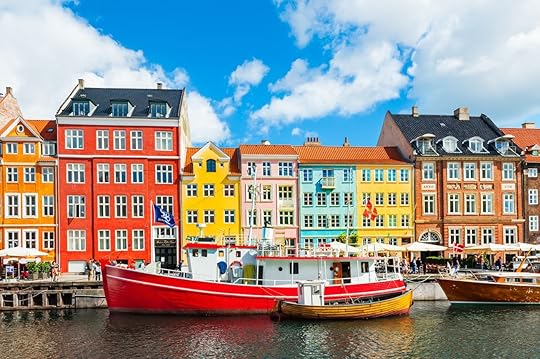
Photo: Olga Gavrilova/Shutterstock
A trip to Copenhagen cannot truly begin without a stop at Nyhavn. Brightly colored buildings, cafes, and restaurants line the canal area. Hans Christian Anderson, author of many famous fairy tales — among them The Little Mermaid and The Ugly Duckling — lived here for a time. Once a home for wild sailor nights, Nyhavn is a great spot to admire wooden boats and people watch, and it’s a great introduction to old Copenhagen.
One of the best times to check it out is later in the evening when the crowds have died down, the lights have turned on, and the sun is setting. That’s in summer; in winter, you’ll have fewer tourists overall but also darkness by 4:00 PM. From Nyhavn, start a tour of the other areas along Copenhagen’s harbor.
Walk the harbor.

Photo: Todamo/Shutterstock
The harbor waters run the length of the city and beyond, creating a mass of interconnected public space that brings together many different city neighborhoods. The water’s edge is lined with shops, cafés, an exercise park, and even a set of trampolines. The waters themselves are filled with sailboats, tour boats, fishing boats, incredibly massive cruise ships, and the odd billionaire’s yacht.
The least expensive way to tour the waters will be simply to stroll the waterside lanes. While walking, it’s possible to soak in all the sites like the Black Diamond, the home of the Danish Royal Library. Other places to check out along the water are the Copenhagen Opera House, Christiansborg Palace, and the spiral tower of the Church of Our Savior. Make a stop at the world famous Little Mermaid, if you must. Another popular free activity in the summer: diving into its waters for a refreshing swim.
Jump in the harbor baths.

Photo: Todamo/Shutterstock
It’s a relatively recent development that the harbor waters became clean enough to swim in, but now that they are, it’s too good of an opportunity to miss. While many locals seem content to jump in from any point near a ladder, sometimes in the nude (brrrr), there are a few places, known as the harbor baths, that are officially designated as swimming areas.
Islands Brygee is one of the most popular of these “baths.” Groups of locals gather together here with their massive speakers, tanning, picnicking, and swimming. There are also many restaurants and spots to grab a drink nearby, but bring your own food for a more affordable meal. The actual bath itself is great both for kids, with its small shallow water sections, and for the braver swimmers who want to jump from heights, as diving platform provides three different levels.
Other less busy swimming spots can be found all along the harbor. Just bring a suit.
Green Kayaks

Photo: GreenKayak/Facebook
There are several ways to get on the water in Copenhagen, from tourist-packed boat tour to private charters and kayaks — but only one of them is free. The Green Kayak program is a great way to take to the waters in Copenhagen and give back at the same time. Green Kayak is a program that allows renters to take out a kayak for two hours, for free, all in exchange for the promise that while out on the water you pick up some trash along the way. It’s a popular activity, so make sure to reserve a time in advance. There are four locations in the city that host the kayaks, but one of them is a bit outside the city center, so for the chance to row around the small boat filled canals, start from the “Friendships” location.
See Copenhagen from above.

Photo: Bucchi Francesco/Shutterstock
Copenhagen is a beautiful city, and one of the best ways to see it is from above. Three towers provide great view points from which to gaze across the city. The highest of these points is the tower at Christiansborg, the home of Danish Parliament and former royal residence. The tower is free for a visit — although it’s closed for renovations until September 1, 2019.
A second great place for viewing the city is the Round Tower. The small charge to visit is only $0.75. Located right in the center of Copenhagen, just off the shopping streets of the Stroget, the round tower provides a 360-degree view of the city. To reach the top of the tower, visitors walk up a wide spiral path originally designed to allow horses pulling carts to bring astronomical equipment to the observatory at the top. The tower has a hollow core that, in one spot, you can step into to look down at the official center point of Denmark.
The final and most expensive option for a great view, at under $10 a person, is the unmistakable spiral tower at the top of the Church of Our Saviour in Christianshavn. Arrive early to beat the crowds and ascend the over-400 steps, both inside and out of the tower, as they spiral toward the pinnacle.
The tower was built in 1752 to house over 50 bells that were played for the residents of Christianshavn. Nowadays, this could be the best place to lookout over the city, but the climb can leave people weak in the knees as the steps towards the top become ever narrower,and the edge closer and closer.
Picnic in the King’s Garden.
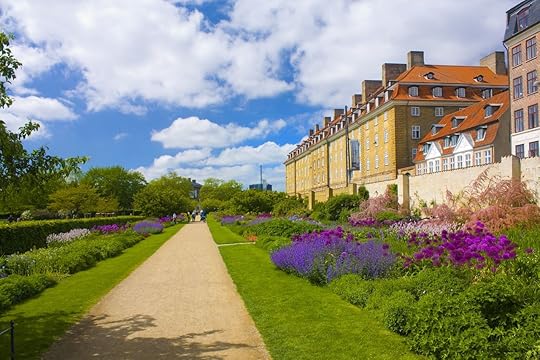
Photo: lindasky76/Shutterstock
Warm sunny days may be a little rarer here, so when the sun does come out, Copenhageners flock to their many beautiful parks. One of the best surrounds Rosenborg Castle, built in 1606 and home to the crown jewels of Denmark. Entrance to the castle, however, is not free (it’s $17 per person), but you will not need to go inside to enjoy the garden. Join the locals here for a bit of sunbathing and picnicking. Public drinking is allowed here, so why not bring a bottle of wine as well — or bring a lawn game and some friends.
Visit Norrebro.
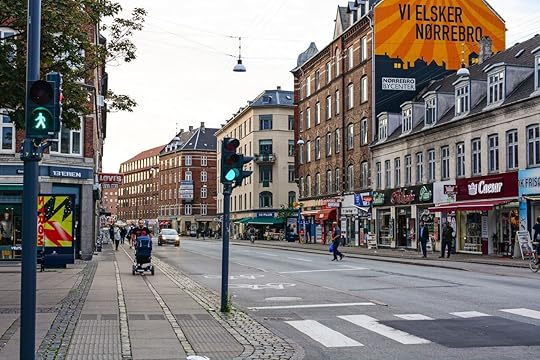
Photo: Kavun Halyna/Shutterstock
Norrebro is many things: the densest neighborhood in the city, the most diverse, and seemingly the hipster center of Copenhagen. This neighborhood will reward anyone willing to throw out the maps — that is, turn of their phones — and simply wander its streets.
Norrebro is just to the west of the city center, across “The Lakes.” Stop at Banana Park where a large rock-climbing wall serves as a grand entrance to the small space. Visit the park to watch the climbers in action, or take a look at some of the best graphite art in the city. The small street Jaegersborggade is a favorite for antique shops and other locally owned shops. Norrebro is also home to one of the most peaceful, and popular, places in the city to escape: Assistens Kirkegård. More on that below.
Tour a cemetery or two.
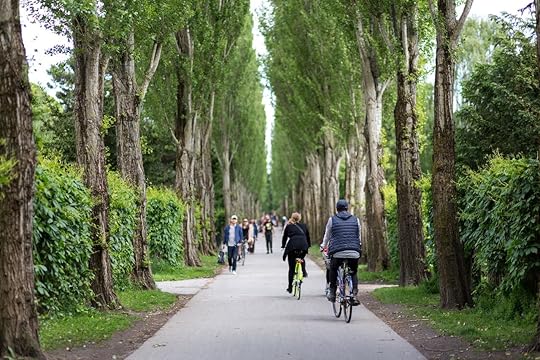
Photo: Oliver Foerstner/Shutterstock
Copenhagen is home to two deeply peaceful and beautiful cemeteries. While locals and tourists alike fill the cemetery grounds, they remain serene escapes in the city. The fact that they are fully functioning cemeteries, as well as popular spots for relaxation and contemplation, make them a truly unique experience.
Assistens Kirkegård, tucked into the bustling streets of Norrebro, is the final resting place of several world famous Danes — among them Hans Christian Andersen, philosopher Soren Kierkegaard, and Nobel prize winning physicist Niehls Bohr. Inside the walls you would never know you were seconds away from some of the most densely populated blocks in Europe. It’s an oasis of peace, filled with well-kept paths, trees, flowers, and chirping birds. Just outside the walls of the cemetery, the best chocolate croissant in the city can be found at Andersen & Maillard.
Vestre Kirkegård is another refuge in the city well worth a visit. The massive, extremely well manicured grounds easily give the botanical gardens a run for their money. In fact, for nature enthusiasts, this cemetery is the superior of the two. A visit to Vestre can be combined with a picnic in the spectacular Frederiksberg Gardens and a walk through the massive Carlsberg facilities.
Window shop the Stroget.
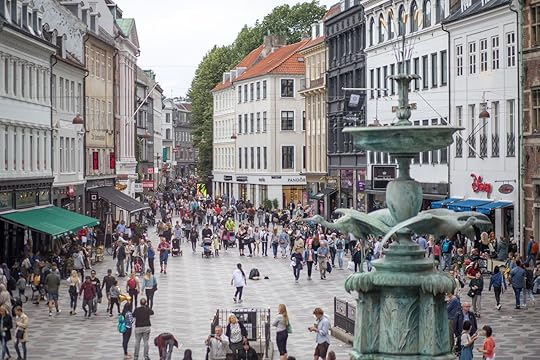
Photo: Oliver Foerstner/Shutterstock
Right in the center of the city is one of the first pedestrian shopping streets in the world. Packed with people during summer days, the Stroget is where to folks shop at some of Denmark’s major brands, as well as worldwide chains. Check out the fashion forward shoes at Arkk, the silver master works at Georg Jensen, the world-famous Royal Copenhagen Porcelain, and don’t miss the flagship Lego store. While you are here, stop at the DOP (Den Økologiske Pølsemand) hotdog stand by the Round Tower for a traditional Danish hot dog.
Day trip to Deer Park, Bakken, and Bellevue Beach.
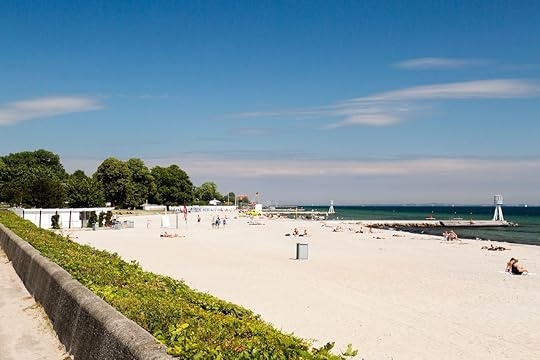
Photo: BIGANDT.COM/Shutterstock
Just a few rail stops, or 20 minutes, outside the center of Copenhagen, it’s possible to get lost in an old royal hunting forest, take in the oldest amusement park in the world, and hit the beach all in one short trip.
Jægersborg Dyrehave was once a royal hunting ground for Danish nobility and is now a UNESCO World Heritage site, as well as the home to the oldest amusement park in the world, Bakken. The forest is often referred to as Deer Park as it boasts hundreds of deer roaming its grounds. At the center of it all is the Hermitage, a grand hunting lodge formerly used by the king.
The Hermitage has a view of much of the hunting grounds, hundreds of deer, and the Oresund Sound in the distance. Rent a bike just after getting off the rail, at the Klampenborg stop, and take a spin around the park. (Baisikeli has the best bike rental deals in Copenhagen, with budget bikes only costing $7.50 for six hours.) On the way out take a short walk through the Bakken Amusement park. (Tivoli will be a better choice for anyone wanting to hit the rides, though at a cost.)
Just a few minutes from the forest, Bellevue Beach has been a refuge for residents of Copenhagen since 1932. On a hot summer day, this is a great place to cool off in the water. The two blue-and-white-striped lifeguard towers were designed by the famous Danish architect Arne Jacobsen, though they are not in use these days.
Bike back into Copenhagen through Hellerup and take in some of the wealthiest neighborhoods in Denmark, with ample opportunity for drooling over prime real estate and luxury cars.
Visit Dragor, a centuries-old fishing village.
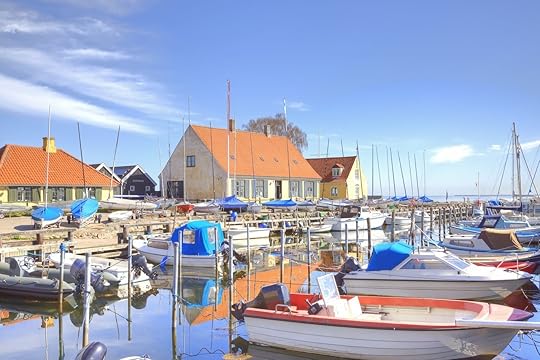
Photo: ppl/Shutterstock
Just south of the airport is the small fishing village of Dragor. It’s possible to get here by taking a bus from just behind the famous Magasin Du Nord shopping center or an eight-mile bike ride. The village itself has been in its place for centuries and is now a quaint, beautiful fishing village filled with cozy lanes lined with thatched roof houses. Dragor’s harbor provides one of the best spots for viewing the Oresund Bridge as well as watching the many ships as they head out to the Baltic Sea. This is a great place to spend a morning or afternoon.
Bike the city.

Photo: William Perugini/Shutterstock
While walking is a great and easy way to see the city, to see Copenhagen like a local, a bicycle is a must. On a bike, almost anywhere in the city is within a 20-minute ride. The bike lanes are wide and often set apart from the rest of the traffic. At first, the bike traffic is likely to look intimidating, but it runs like a well-oiled machine that moves thousands of people through the city hourly. The one thing you will want to watch out for will actually be the other tourists who don’t often pay attention to the bike lane and are likely to pop out in front of you. Don’t be one of these people.
Just remember to get a refresher on hand signals and etiquette because nothing will upset a resident more than inappropriate use of the bike lane. There are shops to rent bicycles all around the city, but if you have a working data plan and a smart phone, Donkey Bikes, a bike-sharing program, is available all over the city and a great option — just download the app and get riding.
Eat inexpensively — and (kind of) splurge on New Nordic cuisine.

Photo: Høst/Facebook
Eating out in Copenhagen can easily break any budget in 10 seconds flat. A filter coffee can run $6 and a craft beer $10. That’s why most of the local skips the bars and take to the streets with a Carlsburg. With access to a kitchen, using the grocery stores will be the best bet. When the weather is nice, picnicking will always be a great option, and the city has so many great places to take a meal. The King’s Garden, Frederiksberg Gardens, or anywhere along the harbor are great options.
A few moderately priced sandwich and pizza shops are available throughout the city. Pizza Husset, a take-out place just off Kongens Nytrov, has some great small pizzas at a reasonable price. For a local treat, head to the market at Torvehallerne — a must see in itself — and pick up a Fisk Frikadeller, a type of fried fish ball reminiscent of a crab cake.
Of course, budgets are relative, and with the whole world going crazy for New Nordic cuisine, eating a meal like this could be an opportunity of a lifetime. However, Noma and its ilk will run you $1,000 or more for two. Høst, however, offers an amazing meal at, for its style, a slightly stomach-able price. It offers a three-course menu that usually comes with a few extras that will cost just above $100 for two people. It’s a once in a lifetime kind of meal. 

More like this: 5 popular European cities where your dollar will go the furthest
The post The best free (and almost free) things to do in Copenhagen appeared first on Matador Network.

Temples to see in Sim Reap

Cycling north along the arrow-straight Avenue Charles de Gaulle out of Siem Reap, you quickly find yourself surrounded by tropical woodland. The shade from the banyans and silk-cotton trees provides a welcome respite from the relentless Cambodian sun, but the thick forest also prevents you from stealing a tantalizing glimpse of Angkor Archaeological Park’s ruined temples until you’re practically upon them.
Not until you swing left onto the park’s main road and ride around a quarter of the perimeter of a 625-foot-wide moat are you finally rewarded with your first look at the grey sandstone outer walls of Angkor Wat, the world’s largest-ever religious structure, looming at the end of a giant raised causeway guarded by ancient lion statues. You’re dripping with sweat, but you hardly notice — this is one of the most beautiful and imposing buildings anywhere on Earth.
Angkor is Cambodia‘s most-visited tourist attraction. Despite a hike in ticket prices in February 2017, tourists are flocking to the ancient capital of the Khmer Empire in ever-greater numbers, with 2.6 million people exploring its expansive crumbling ruins in 2018, according to the Phnom Penh Post.
Yet even though it’s one of the world’s most famous historic attractions, most visitors only spend a day here, cycling or taking a tuk-tuk tour of Angkor Wat and the park’s two other big-hitters — Bayon and Ta Prohm. While undoubtedly spectacular, they’re also extremely popular. Expect to spend a lot of time stuck in a scrum of fellow tourists, especially if you’re trying to take pictures of the most Instagrammable spots.
But there is another option: There are dozens more incredible ruins in and around the Angkor park. Far from finding yourself stuck behind coach-loads of sightseers, you can visit most of these ancient temples and hardly see another person. Here are our nine favorite temples near Siem Reap that aren’t Angkor Wat.
Within Angkor Archaeological Park
All of the following ruins are part of the main park but beyond the reaches of the regular tourist route. At a push, you could reach all of them by bicycle over the course of a three-day visit (although expect to feel a little saddle-sore and sunburned at the end of it).
If you’d rather tour the sites in relative comfort, a tuk-tuk is your best bet. Drivers will happily take you wherever you wish for a ridiculously small fee; competition is so fierce that they typically charge just $15 for the so-called Small Loop that encompasses the main attractions. Be sure to tip generously — the cost of living in Cambodia is low, but $15 for a full day’s work simply isn’t enough to support the drivers and their families.
1. Neak Pean

Photo: Cocos.Bounty/Shutterstock
Fewer than four miles northeast of Angkor Thom’s towering, lichen-covered northern gate, Neak Pean is a tiny, beautiful ruined temple in the middle of a huge man-made lake. Built in the late 12th century, it was effectively the Khmer equivalent of a Roman bathhouse. Four connected pools representing the four elements — earth, fire, water, and wind — are located at the heart of the artificial island within the temple; it was believed that entering the waters would cure diseases.
This tranquil, uncrowded corner of the archaeological park is a fantastic spot for some quiet contemplation. Stroll around the edge of the pools, listening to the gentle tweeting of kingfishers and the occasional rippling of the water, and you’ll forget that you’re within a few hundred feet of thousands of other visitors.
However, the real star attraction here is the walk to the temple. Crossing the wooden walkway that leads across the Jayatataka Baray, the vast reservoir that surrounds the island, is an experience in itself.

Photo: Karen.T/Shutterstock
After the collapse of the Angkor kingdom, the baray fell into disrepair and completely dried out, allowing woodland to reclaim the former lakebed. But with the damage now fixed, it refills every wet season, flooding the roots and killing the trees. When the dry season causes the reservoir to retreat once more, the dying forest bursts back into life. Apparently healthy trees grow alongside twisted trunks and branches protruding from the lake, with the whole scene reflected in the opaque waters below.
2. Ta Keo

Photo: Arkady Zakharov/Shutterstock
Pyramids are more often associated with Ancient Egypt or the powerful Aztec and Mayan empires of Mexico and Central America, but the ancient rulers of Angkor built them, too.
One of the oldest examples — and possibly the first Khmer temple to be built entirely from the empire’s trademark sandstone — is Ta Keo. It lies just outside Angkor Thom’s eastern gate, one mile north of Ta Prohm, the overgrown “Tomb Raider temple” made famous by Angelina Jolie.

Photo: Diego Fiore/Shutterstock
This massive Hindu pyramid, built a century before Angkor Wat, was never finished. Inscriptions claim that the structure was hit by lightning, which was interpreted as a bad omen, prompting construction to be abandoned.
Finished or not, the terraced pyramid is an imposing sight, looming 65 feet above the jungle floor. Unlike at many other Angkor ruins, you can climb right to the top for vertiginous views of the verdant forest surrounds.
3. Preah Khan

Photo: Efired/Shutterstock
On the western bank of the Jayatataka Baray, the temple of Preah Khan is a blend of Buddhist and Hindu themes, making it one of the most architecturally diverse structures in the whole park.
In reality, the term “temple” doesn’t do it justice. In its heyday, Preah Khan was also home to a Buddhist university attended and maintained by almost 100,000 officials and servants.
As with Ta Prohm, Preah Khan had been buried in jungle flora for centuries before it was “rediscovered” by French archaeologist Maurice Glaize in 1939. Along with the rest of Angkor, it had been abandoned by the Khmers in the 15th century; the capital moved to Phnom Penh to protect against regular military incursions from the neighboring king of Ayutthaya and better facilitate trade with China and Japan. On his discovery, Glaize remarked that Preah Khan had been “overrun with a particularly voracious vegetation and quite ruined.”

Photo: Sergey Peterman/Shutterstock
Restoration work has mostly beaten back the jungle’s advance, but what remains of the site is a sprawl of tumbledown sandstone walls, pillars, and archways, many of which are enveloped in the tangled roots of prodigious silk-cotton trees. Unlike Ta Prohm, it’s no problem to find a quiet spot to yourself, and you won’t spend your time being elbowed out the way by overeager photographers.
4. Baphuon

Photo: Anton_Ivanov/Shutterstock
Despite being right at the heart of Angkor Thom, Baphuon — the 3.5-square-mile, laterite-wall-enclosed space that was once the royal capital — attracts just a fraction of the visitors of nearby Bayon.
It’s difficult to work out why Baphuon isn’t more popular. Built in the temple-mountain style, its every surface is covered with intricate carvings. Squint at the western edge of the temple’s second tier and you should just be able to make out the remnants of a vast reclining Buddha, measuring 70 meters long and nine meters tall.

Photo: Kenny CMK/Shutterstock
It’s also worth mentioning Baphuon’s fascinating recent history. Such was its state of collapse that in the mid-20th century, the extreme decision was taken to dismantle the temple piece by piece, reinforce its central core, then rebuild it anew. But disaster befell the project in 1970 with the breakout of the Cambodian Civil War, during which the painstakingly assembled plans required to identify the temple’s 300,000 building blocks were destroyed by the Khmer Rouge.
Reconstruction efforts began again in 1996 and were only completed in 2011. At the time, project leader Pascal Royer said the mission was like tackling “a kind of jigsaw puzzle without the picture how to rebuild it”.
5. Banteay Kdei

Photo: withGod/Shutterstock
One of the easternmost temples within the archaeological park, Banteay Kdei is peaceful, sparsely attended, and utterly confusing. It’s stylistically similar to Ta Prohm and Preah Khan, albeit less sprawling, but Banteay Kdei is proof that good things can come in small packages.

Photo: Janelle Lugge/Shutterstock
The Khmer name translates as “A Citadel of Chambers,” and it’s not hard to see why. The ruins comprise a warren of rooms; some are connected while others are blocked by rockfalls and interloping trees. Remarkably, this seemingly precarious structure — which is actually perfectly safe thanks to extensive renovation work — was still occupied by Buddhist monks as recently as the 1960s.
6. Ta Som

Photo: Efired/Shutterstock
Another of the ancient temples dotted along the shores of the Jayatataka Baray, Ta Som occupies the opposite shore to Preah Khan. A little more than five miles from the center of Angkor Thom, it’s far from the tourist hordes of the park’s main attractions.

Photo: TurneroundDesigns/Shutterstock
Despite being among Angkor’s more diminutive ruins, Ta Som is home to one of the park’s most impressive sights. The eastern gopura (monumental entrance tower) has, down the centuries, become engulfed by an enormous — and appropriately named — strangler fig tree. No doubt the temple was beautiful in its heyday, but it’s hard to imagine that it looked any more impressive than in its current, gloriously dilapidated state.
7. Phnom Bakheng

Photo: gumbao/Shutterstock
While a small but striking ruin in its own right, the hilltop temple of Bakheng is mostly worth visiting for the incredible views it offers of neighboring Angkor Wat.
Phnom Bakheng is reached by a long, steep path to the east of the temple, but the climb is well worth the effort. Once you’ve reached the summit, you’ll be able to enjoy perhaps the best view of Angkor Wat to be found anywhere in the park; you can make out all five of the temple’s main towers from here (which you can’t even do from the entrance of Angkor Wat itself).

Photo: Chen Liji/Shutterstock
Despite the somewhat arduous trek to the top, Bakheng is more popular than any of the other ruins in this section, particularly at sunrise and sunset. It’s much quieter at midday, although the scorching noon sun won’t make the walk any easier.
Outside Siem Reap
Don’t expect to reach these two on a bicycle. The first is about an hour’s drive from Siem Reap, the second more than two hours. You’ll either need to hire a tuk-tuk or taxi — the latter will obviously be more comfortable but also more expensive — or pick up some wheels yourself. Rent a car and you can see both in a relatively sedate two days or an intense single day if you’re pushed for time.
1. Prasat Banteay Srei

Photo: Noppasin Wongchum/Shutterstock
Petite, pretty, and blissfully quiet, Prasat Banteay Srei is located about an hour’s drive north of Siem Reap and 20 miles from the archaeological park. It might not be part of the main park, but your standard Angkor ticket will still get you in (in fact, you can’t access the site without one).
Set within an immense forest, the pink sandstone temple has a fairytale feel, aided by its diminutive stature, superb state of preservation, and intricate carvings. Architecturally, it looks more akin to an ancient Indian temple than any of the other Angkor ruins. A series of small pools ring the inner walls, beautifully reflecting the three ornately carved towers at the temple’s center.
2. Koh Ker

Photo: Visualize Creative/Shutterstock
Given its 70-mile distance from the Angkor park, you’ll need to pay a separate $10 admission to Koh Ker, but it’s worth the money. More than just a temple ruin, it’s actually a whole ancient city that served as the capital of the Khmer Empire and housed more than 10,000 citizens, hundreds of years before the construction of Angkor Thom.
There are 184 individual monuments within the city limits, although only a dozen are open to the public; the surrounding areas are yet to be cleared of landmines, a stark reminder of the country’s recent turbulent history.
The star attraction here is Prang, a mammoth, seven-tiered pyramid that looms out of the thick surrounding greenery. While the original steps have eroded, you can scale the temple via a recently constructed wooden staircase for views of jungle stretching to the horizon. The complete absence of crowds heightens an already serene experience. 

More like this: Cambodia to stop elephant rides at Angkor Wat by 2020
The post 9 stunning temples you need to see near Siem Reap, besides Angkor Wat appeared first on Matador Network.

Why are there so many KFCs in Asia

The smiling mug of Colonel Sanders is a familiar face across Asia, from Bangkok to Beijing, and everywhere in between. But how did KFC become so popular, even more popular than the poster child for globalization, McDonald’s? The answer is multi-faceted and stems largely from the company’s keen ability to be in the right place at the right time.
Kentucky Fried Chicken has more than 5,600 locations in China alone, making it by far the most dominant American fast-food chain in the country. According to Business Insider, KFC holds 11.6 percent of the fast-food market in China — double that of McDonald’s and lightyears ahead of any other US-based chain.
There was an initial allure to eating Western food that came about when China opened up to foreign investment in the mid-1980s. Eating American food became kind of like taking a mini-tour of the United States itself. KFC was there early on to capitalize on the new market and that Western-food desire in all its greasy glory.
When KFC first opened in Beijing in 1987, it was widely viewed as a step forward in China’s opening up to the world. For many Chinese, KFC was their first taste of American culture right when the country first allowed bits and pieces of outside influence to creep in. This reaction was replicated over and over again at a rapid rate — at one point in the 2010s, KFC opened a new location in China every 18 hours — as the company expanded across the country. Residents were so excited at the opening of a KFC store there that they welcomed the restaurant with a full-scale parade, floats and all.
“KFC was seen as epitomizing western living,” says John Christen, an educator from Colorado who taught English in Yongji, a county-level city of about 450,000 people in Shanxi Province. “A bowl of noodles from the local restaurant may have been six yuan, or a dollar, and a KFC meal maybe 35 yuan, or six bucks. So the thinking is, ‘If I can afford the food, I am rich like an American.’ There is a big push for middle-class families to have the luxuries of the West. It’s all in an attempt to live like an American.”
To cater to local tastes, some KFC locations offer localized menu items in addition to the classic bucket. In China, for example, you might find a take on one of KFC’s most classic options, the Twister, spiced up with cucumbers, scallions, and duck sauce and re-dubbed the Dragon Twister. There’s also the Tender Beef Pentagon, which resembles Taco Bell’s Crunch Wrap Supreme. Chicken biryani is on the menu in Sri Lanka, and Thailand stores sell a shrimp donut.
The Original Recipe fried chicken remains the top seller, though, and even as the novelty of eating American fast wood waned, KFC stores remain packed — KFC did nearly $5 billion in sales in China alone throughout 2018. KFC’s parent company Yum Brands, which also owns Taco Bell and Pizza Hut, has in the past made more than 40 percent of its total profit in China, led in large part by KFC. That’s some serious dough and batter.
Convenience that crosses religious boundaries.

Photo: Chintung Lee/Shutterstock
It isn’t just the appeal of Western food that keeps KFC thriving. Unless you’re vegan, vegetarian, or pescatarian, chicken is likely on the approved list for your diet — including for religious diet restrictions. While Muslims don’t eat pork and non-vegetarian Hindus don’t eat beef, pretty much all of the world’s major religions allow consumption of chicken. That makes KFC a more accommodating choice than, say, Burger King.
According to Cornell University Library, more than 60 percent of the world’s 1.57 billion Muslims live in Asia. In Indonesia, the world’s largest Muslim-majority nation, KFC has over 400 locations, primarily in bigger cities where residents commute to and from work. When it comes to buckets of fried chicken, KFC is convenient for pretty much everyone.
The formula there is nothing new — the Colonel is there when and where you need him, and the pick-up-and-go strategy has worked out nearly as well for them across the Pacific as it has back home. The Bangkok Post reported that the company hopes to open its 1,000th location in Thailand in 2020, and the food blog Fast Food Menu Prices clocks another 640 KFC restaurants across India and the rest of Southeast Asia.
In Japan, the convenience also stretches to holidays. Since the run of a popular 1974 advertisement declaring Kurisumasu ni wa kentakkii (Kentucky for Christmas), KFC has been a staple for Japanese Christmas dinners.
In areas like Macau, an autonomous region of China that doesn’t have widespread religious dietary restrictions, breaded and fried chicken has been an easier sell than other Western foods.
“People here don’t like burgers, but they still want American fast food,” said Ken Chi Hou Lee, a Local Guide with Macau Government Tourism. “KFC provides that greasy fix without having to eat a burger, and that’s a big part of why people in Macau love it.”
Even after all these years, KFC’s allure endures.

Photo: TY Lim/Shutterstock
Just like in the United States, the appeal of KFC in Asia also comes down to something simple: It tastes really damn good. The Colonel’s secret herbs and spices recipe gives KFC an air of mystery while also being straight-up addictive. Cooks in China, Thailand, Indonesia, and everywhere else have had just as little luck cracking the secret recipe as Americans have. It’s unlikely the secret will spill anytime soon, either — the recipe remains locked inside a vault somewhere in Louisville, and the spice mix itself is blended by two different companies so as not to make the full ingredient list available to anyone. As the company continues to expand across the world’s most populous continent, one thing remains clear: Fried chicken’s popularity shows no signs of kicking the bucket. 

More like this: A KFC in Australia is campaigning for a Michelin star
The post How KFC came to dominate fast food in Asia appeared first on Matador Network.

The best camping meal ideas

It’s easy to screw up what food to bring camping. While pretty much all camp-made food worth noting has the delicious uniting factor of being cooked over the coals of a live fire, there are a lot of half-baked weenies and scorched s’mores out there. Chefs, however, do it right when it comes to the best food to take camping.
We reached to chefs around the US to find the best camping food ideas for breakfast, lunch, dinner, and dessert. Because when you find time in your busy schedule for a camping trip, few things beat a good meal around the fire.
Foil-pocket dinners
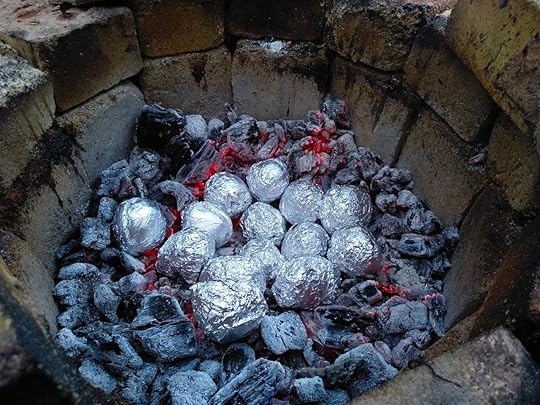
Photo: Marush/Shutterstock
If there are two things that everyone can agree on about camping meals, it’s that it should be easy and tasty. Few things are as easy, or as flavor-stuffed, as a packet of foil filled with meat and vegetables.
“My go-to camping meals are foil-pocket dinners,” says Bryant Kryck, chef at CRAFTpdx in Portland, Oregon. “You cut all of your vegetables and meats at home, place them in Ziploc bags and into a cooler.” Once ready to start cooking, empty the bags (Kryck likes peppers, mushrooms, chicken, onions, rice, a splash of beer, and cream of mushroom soup) into foil and wrap it tightly. Let it cook against a rock near the flames for 20 to 30 minutes and enjoy.
What you put in your foil pocket is up to you. Pork and pineapple is a good combo, as is shrimp and andouille sausage with Cajun seasonings. You can also use foil pockets to cook your sides, suggests Josiah and Shannon McGaugher, chef/co-owner and co-owner of Vivian in Asheville, North Carolina. They’ll fill the foil with diced vegetables like eggplant, peppers, and potatoes with butter and cook it in the coals while roasting a whole protein over the fire (bacon-wrapped rabbit stuffed with foraged angelica has been one of their standouts).
Pro tip: “Do all the prep and cuts at home before you get to the campsite so you can enjoy yourself hanging with friends and relaxing and all you have to do is fill your foil pockets,” says Bill Espiricueta, executive chef and owner of Smōk in Denver.
Kimchi-jjigae

Photo: Carlos Huang/Shutterstock
When Kyoo Eom, executive chef at Washington DC’s Dirty Habit, goes camping in Virginia’s Shenandoah Mountains with his family, he whips up a meal that his mom made on camping trips as a kid: kimchi-jjigae.
Kimchi-jjigae is a type of kimchi stew. “It’s spicy, hot, and full of rich umami flavor,” Eom says. “When we ate it back then, it instantly warmed my entire body and offered so much comfort.”
When you make it, stick to the simple version, “and don’t get too wild,” Eom says. “Just sear the pork belly (in a cast-iron stew pot). The fat renders from it and you can sautee the kimchi with that. Add the kimchi liquid, bring it to a boil over the flame and simmer. If you need a little water that’s fine, but don’t boil it or you lose the flavor. Simmer for an hour and that’s it! Plenty of time for the kids to go for a swim.”
Peach cobbler

Photo: Jed Packer/Shutterstock
There’s nothing wrong with a good s’more, but there’s a whole world of desserts out there to be enjoyed around the campfire. William Schultz, executive chef at the Fairmont Chicago, Millennium Park, uses a Dutch oven to make a peach cobbler when camping with his wife. Dutch oven camp cooking opens the door to a range of recipes that can’t be made over an open flame, and desserts are up there with the best of them. Schultz buries his Dutch oven in coals under the fire for a crispy crust and moist center. Brown sugar, butter, and rolled oats go on top for a crunch, and to go the extra mile, Schultz pairs the cobbler with some homemade ice cream.
Whole fish

Photo: Fabian Plock/Shutterstock
Skip fish filets, which can fall apart over the fire if you’re not careful, for a whole fish. Bonus points if you catch the fish yourself.
“I always leave the fish whole,” says Chris Royster, executive chef and partner at Flagstaff House Restaurant in Boulder, Colorado. “Clean and then fill with fresh herbs and lemon, especially for trout. Cook over the lower heat side so the fish begins to get smoky.”
He’s not alone in his whole fish preference.
For the perfect fish, Daniel Morel, chef at Fairmont Le Chateau Montebello, has a few tips (plus the reassurance that all you need is some foil, lemon, garlic, rosemary, olive oil, twine, and salt). First, if you’re cooking your own catch, clean out the stomach and liver because it has a strong iron taste that’ll takeover. Fill the fish evenly with the herbs and spices, tie it shut, and wrap it twice in tinfoil. Cook it directly on the embers of a fire (around eight minutes each side for a decent-sized trout).
Don’t feel limited to eating as-is when it’s done.
“My go-to is whole roasted fish, which you can flake to turn it into tacos with salsa verde, and serve with a charred corn and cherry tomato salad,” says chef Matt Sigler of Portland, Oregon’s Il Solito. “The coals are a great way to cook while camping. I always cook corn in husks inside the coals, and you can also char a whole onion in the coals and slice for tacos.”
Tacos

Photo: Deirdre Garza/Shutterstock
Speaking of tacos, don’t limit your options to fish.
“You already have an open fire to grill whatever meat you’d like to use as well as any vegetables, and you can throw your tortillas in a pan to warm them up,” says Diana Dávila of Chicago’s Mi Tocaya Antojería. “You can also make your salsa in a pot on the campfire as well — just mash it as its cooking”
Instant ramen and Korean-style short ribs

Photo: VDB Photos/Shutterstock
“Marinated Korean-style short ribs are my favorite, they are super tasty, cook very fast, and generate an awesome smoky beefy aroma that may attract new friends on any campgrounds,” says Thach Tran, executive chef at Ace Eat Serve in Denver. “Another go-to is instant ramen, Shin Black Label to be specific, but whatever works for you! Instant ramen is instant comfort when it is dark and cold, a great late-night, go-to meal.”
Fancy hot dogs

Photo: Sheila Fitzgerald/Shutterstock
Hot dogs are the pop music of food. A hot dog can be low-brow and stripped down to the basics (ketchup and mustard) or elevated with ingredients — both have mass appeal. Julio Peraza, chef at fl.2 at Fairmont Pittsburgh, cooks natural-casing hot dogs wrapped in smoked bacon while camping, then tops them with guacamole, caramelized onions, and sautéed bell peppers.
“Growing up, this was our go-to for camping with my parents,” Peraza says. “It makes for an easy lunch or dinner. We always had it the first night we got to the campsite. It’s easy to prepare, and a hot dog with bacon – what’s not to love?”
Pro tip: Tuck the bacon into itself because it shrinks when cooking.
Shakshuka

Photo: Daniel Vav/Shutterstock
“My go-to camping meal has to be shakshuka, which is basically a rich tomato gravy with eggs poached into the sauce,” says Jessica Hazard, a chef who has worked for Disney World and President George Bush. “It can be as complicated or as simple as you want it to be as the two main components are just tomato and eggs. And it’s great for breakfast, lunch AND dinner!”
Shakshuka can be made with whatever is on hand. All you really need is pureed tomato (can be canned), a bouillon cube, and eggs. Spices like cumin, paprika, red pepper flakes, and harissa paste are typically added, as well as some greens and herbs. For the best shakshuka, use room temperature eggs (it cooks more evenly) and a tomato sauce that’s simmered low and slow.
Overnight-cooked brisket and pork shoulder

Photo: Imfoto/Shutterstock
While the foil pocket dinner is popular, there’s a larger-scale way of cooking with the method that takes just a little more prior planning: foil-wrapped brisket or pork shoulder.
“One of my favorite (and easiest) things to do is season it really generously with salt and pepper, then wrap in several layers of foil (you want to make sure it cooks through without getting scorched),” says Adam Vero, executive chef at Denver’s Hearth & Dram.
Simply bury the foil-wrapped meat under the hot coals before calling it a night and when you wake up, you’ll have a slow-cooked meal ready and waiting for you.
Ash-roasted yams

Photo: Nopparat Promtha/Shutterstock
Dinesh Jayawardena, executive sous chef at FireLake Grill House & Cocktail Bar, Mall of America, in Bloomington, Minnesota, also looks to her childhood for inspiration. Jayawardena grew up in Sri Lanka and would help her kiri-amma (grandmother) with the gardening. Come yam season, that meant helping out with the harvesting — and some of the eating.
Jayawardena would dig the yams up and dust them off while her kiri-amma started a wood fire. The collection of yams were then thrown straight onto the glowing wood coals. “I remember thinking, ‘How am I going to eat this? It is going to be ash soon,’” Jayawardena says.
The yams stay on the coals for a few minutes before being taken out, plated, and cracked open.
“The hot, steamy, roasty smell and taste is something I will never forget,” Jayawardena says. “Sharing that moment with my kiri-amma was one of the fondest moments of my childhood. That’s why with every chance I get I bring it back when camping throughout the wilderness of my now-home-state of Minnesota.”
This works for any root vegetable, Jayawardena says, including onion, rutabaga, carrot, parsnip, or celery. Yams have a high sugar content that makes them particularly ideal, however, as they take on the flavor of the coals to balance the natural sweetness. 

More like this: Dutch oven cooking is the best way to eat well while camping
The post The best food to make while camping, according to chefs appeared first on Matador Network.

Matador Network's Blog
- Matador Network's profile
- 6 followers



